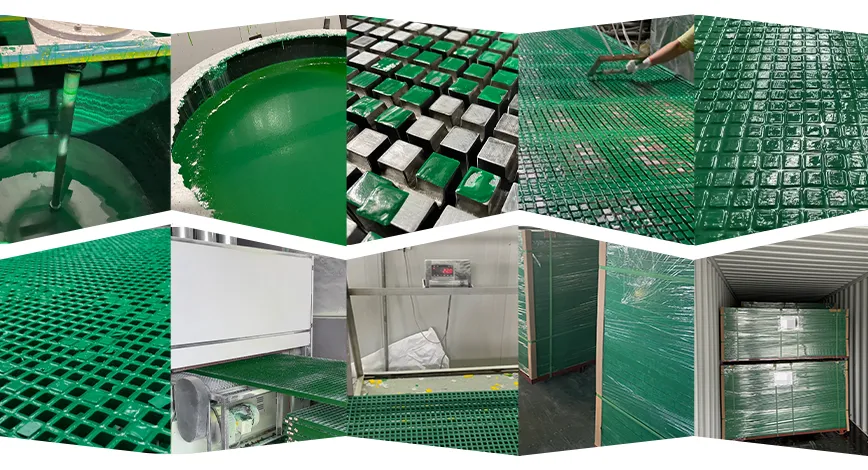loading...
- No. 9, Xingyuan South Street, Dongwaihuan Road, Zaoqiang County, Hengshui, Hebei, China
- admin@zjcomposites.com
- +86 15097380338
- Welcome to visit our website!
gfrp grating
The Advantages and Applications of GFRP Grating
Glass Fiber Reinforced Polymer (GFRP) grating has gained significant popularity across various industries due to its exceptional properties and versatility. This advanced composite material combines glass fibers with a polymer matrix, resulting in a lightweight, strong, and corrosion-resistant product that can be used in a myriad of applications. In this article, we will delve into the advantages of GFRP grating and explore its diverse applications.
What is GFRP Grating?
GFRP grating is a type of industrial flooring product made from glass fiber reinforced polymer. It comes in various forms, including solid sheets or lattice-like structures, allowing for effective load-bearing capabilities while minimizing weight. The manufacturing process typically involves embedding glass fibers in a polymer resin, which is then cured to form a durable and resilient structure. This process not only enhances the material’s mechanical properties but also contributes to its resistance against harsh environmental conditions.
Key Advantages of GFRP Grating
1. Corrosion Resistance One of the standout features of GFRP grating is its excellent corrosion resistance, making it an ideal choice for environments exposed to chemicals, salts, and moisture. Unlike traditional materials such as steel or aluminum, GFRP does not rust or corrode, ensuring a longer lifespan and reducing maintenance costs.
2. Lightweight GFRP grating is significantly lighter than metal alternatives, which makes it easier to handle and install. This can result in lower transportation costs and simpler installation processes, especially in challenging environments or locations.
3. Non-Conductive The non-conductive nature of GFRP makes it a preferred choice in electrical applications. It prevents the risk of electrical conductivity, making it safe for use in environments where electrical hazards may be present, such as power plants or transformer stations.
4. High Strength-to-Weight Ratio GFRP grating possesses a high strength-to-weight ratio, meaning it can bear substantial loads while remaining lightweight. This property allows for innovative designs and applications that can capitalize on both strength and efficiency.
5. UV Resistance GFRP materials are inherently resistant to UV radiation, which helps maintain their structural integrity and appearance even when exposed to sunlight. This is particularly beneficial for outdoor applications where sunlight can cause degradation in other materials.
gfrp grating

6. Customizability GFRP grating can be manufactured in various sizes, shapes, and colors to meet specific project requirements. This customization allows for tailored solutions across different industries, providing both functional and aesthetic benefits.
Applications of GFRP Grating
1. Industrial Flooring GFRP grating is widely used in industrial flooring systems, providing safe walking surfaces in factories, warehouses, and processing plants. Its slip-resistant properties are crucial in environments where spills or wet conditions may occur.
2. Walkways and Platforms Many industries utilize GFRP grating for constructing walkways and elevated platforms. The lightweight nature and corrosion resistance make it ideal for offshore platforms, chemical plants, and water treatment facilities.
3. Marine Applications The marine industry benefits greatly from GFRP grating, as it can withstand harsh saltwater environments. Its non-corrosive properties make it suitable for use in docks, piers, and boat ramps.
4. Wastewater Treatment Plants GFRP grating is highly sought after in wastewater treatment plants due to its resistance to corrosive chemicals and moisture. Its durability ensures reliability in demanding applications where traditional materials may fail.
5. Transportation In the transportation sector, GFRP grating is utilized for railway platforms, footbridges, and pedestrian walkways, offering a lightweight solution that meets safety regulations and enhances durability.
6. Architectural Features GFRP grating can also serve aesthetic purposes in architectural designs, providing visually appealing solutions that do not sacrifice performance and safety.
Conclusion
In conclusion, the benefits and versatility of GFRP grating make it an exceptional choice for various applications. Its corrosion resistance, lightweight properties, and strength make it suitable for demanding environments, while its customization options allow for tailored solutions. As industries continue to seek more efficient and durable materials, GFRP grating is undoubtedly poised to play a significant role in shaping the future of construction and design. Whether for industrial, marine, or architectural use, GFRP grating stands out as a material that meets both functional and aesthetic requirements.
-
The Rise of FRP Profiles: Strong, Lightweight, and Built to LastNewsJul.14,2025
-
SMC Panel Tanks: A Modern Water Storage Solution for All EnvironmentsNewsJul.14,2025
-
GRP Grating: A Modern Solution for Safe and Durable Access SystemsNewsJul.14,2025
-
Galvanized Steel Water Tanks: Durable, Reliable, and Ready for UseNewsJul.14,2025
-
FRP Mini Mesh Grating: The Safer, Smarter Flooring SolutionNewsJul.14,2025
-
Exploring FRP Vessels: Durable Solutions for Modern Fluid HandlingNewsJul.14,2025
-
GRP Structures: The Future of Lightweight, High-Performance EngineeringNewsJun.20,2025
